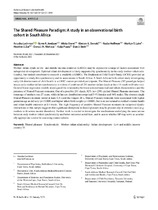| dc.contributor.author | Lachman, Anusha | |
| dc.contributor.author | Jordaan, Esme R | |
| dc.contributor.author | Stern, Micky | |
| dc.date.accessioned | 2022-01-18T14:05:55Z | |
| dc.date.available | 2022-01-18T14:05:55Z | |
| dc.date.issued | 2021-07 | |
| dc.identifier.citation | Lachman, A., et al. "The Shared Pleasure Paradigm: A Study in an Observational Birth Cohort in South Africa." Archives of Women's Mental Health, 2022. SCOPUS, www.scopus.com, doi:10.1007/s00737-021-01199-0. | en_US |
| dc.identifier.uri | doi:10.1007/s00737-021-01199-0. | |
| dc.identifier.uri | http://hdl.handle.net/10566/7120 | |
| dc.description.abstract | Mother–infant dyads in low- and middle-income countries (LMICs) may be exposed to a range of factors associated with
suboptimal development. Optimal infant development is likely supported by synchronicity in the early mother–infant relationship, but limited corroborative research is available in LMICs. The Drakenstein Child Health Study (DCHS) provided an
opportunity to study this synchronicity and its associations in South Africa. A South African birth cohort study investigating
early-life determinants of child health in a LMIC context provided participants. The Shared Pleasure (SP) paradigm helped
assess early mother–infant synchronicity in videos of a sub-set of 291 mother–infant dyads at their 14-week well baby visit.
General linear regression models investigated the relationship between selected maternal and infant characteristics and the
presence of Shared Pleasure moments. Out of a possible 291 dyads, 82% (n=239) yielded Shared Pleasure moments. The
mean age of mothers was 27 years, while infant sex distribution comprised 54% females and 46% males. The shortest single
Shared Pleasure moment lasted at least 0.5 s and the longest 28 s. Shared Pleasure moments were associated with higher
gestation age at delivery (p=0.008) and higher infant birth weight (p=0.006), but were not related to mother's mental health
and infant health outcomes at 14 weeks. The high frequency of positive Shared Pleasure moments in reciprocal dyadic
interactions in this sample suggests that signifcant disruption in shared pleasure may be present only in extreme cases (e.g.
mothers with severe mental disorders). Further work is needed to investigate the mechanisms underlying the associations
between early mother–infant synchronicity and better o | en_US |
| dc.language.iso | en | en_US |
| dc.publisher | Springer | en_US |
| dc.subject | Shared pleasure | en_US |
| dc.subject | Mother–infant relationship | en_US |
| dc.subject | Synchronicity | en_US |
| dc.subject | Infant development | en_US |
| dc.subject | Low and middle-income | en_US |
| dc.title | The shared pleasure paradigm: A study in an observational birth cohort in South Africa | en_US |
| dc.type | Article | en_US |

